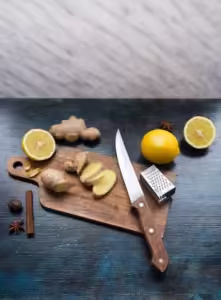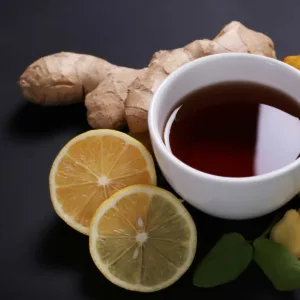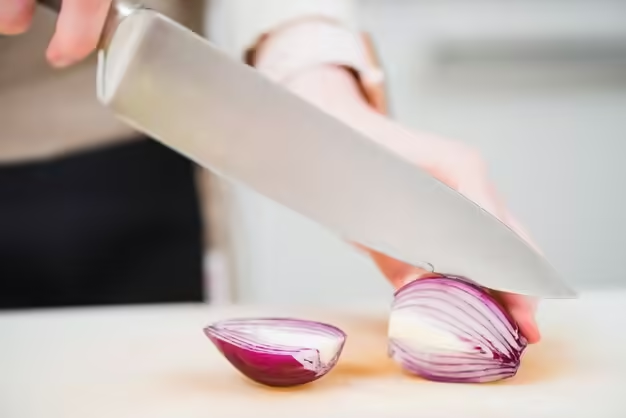This guide, show you how to mince garlic properly, why it matters, and some helpful tips and tricks to make the process easier.
Table of Contents
Why Garlic is So Important in Cooking
How to Mince Garlic make a huge difference in how much flavor it delivers to your recipes.
Garlic isn’t just any ordinary ingredient; it’s a culinary powerhouse.
For centuries, it has been used in kitchens across the world, not just for its rich flavor but also for its health benefits.
The unique smell and taste of garlic come from its sulfur compounds, which are released when the garlic is cut or crushed.
But did you know that how you prepare garlic significantly impacts its flavor?
A whole clove, crushed clove, sliced garlic, and minced garlic all produce different intensities of taste.
Minced garlic, in particular, releases more of the garlic’s oils, giving your dishes a sharper and more pronounced flavor.
Beyond taste, garlic offers a range of health benefits. It’s known to boost the immune system, improve cardiovascular health, and has natural anti-inflammatory properties.
So, when you’re adding garlic to your meals, you’re not just enhancing flavor—you’re also contributing to better health.
Tools You’ll Need for How to Mince Garlic

Before we jump into the process of How to Mince Garlic , it’s important to gather the right tools.
- A Sharp Chef’s Knife
A sharp knife is crucial when How to Mince Garlic . A dull knife can crush the garlic rather than chop it cleanly, leading to uneven pieces and potentially releasing more bitterness. A sharp blade will allow for a finer and more consistent mince. - A Cutting Board
Use a stable cutting board, preferably one made of wood or plastic. Avoid glass cutting boards as they tend to dull knives more quickly and can be slippery. - A Garlic Press (Optional)
If you prefer not to mince garlic by hand, a garlic press can help. It quickly crushes garlic, producing a finely minced consistency without much effort. While a garlic press can be convenient, some cooks argue that it mashes the garlic too much, altering the flavor and texture. - A Garlic Peeler (Optional)
Peeling garlic can be a hassle, but a silicone garlic peeler can make it easier. Just roll the garlic clove inside the peeler, and the skin will come right off.
Step-by-Step Guide: How to Mince Garlic
Now that you have your tools ready, let’s go through the step-by-step process of How to Mince Garlic
Step 1: Choosing Fresh Garlic
Start by selecting fresh garlic. Look for a garlic bulb that is firm, with no visible soft spots or bruises.
The cloves should be tightly packed within the bulb. Fresh garlic will provide the best flavor and texture for your dish.
Step 2: Separating and Peeling the Cloves
To begin, break apart the bulb of garlic and remove the number of cloves you need.
Place the flat side of your knife on top of each clove and gently press down.
This will crack the clove slightly, making the skin easier to peel off.
Once the skin is off, you’re ready to mince.
Step 3: Slicing the Garlic
Place the peeled garlic clove on the cutting board and use your knife to slice it thinly.
Slice the clove lengthwise into thin pieces. This step will help create uniform pieces when you start mincing.
Step 4: Mincing the Garlic
Once the garlic is sliced, gather the slices into a small pile. Place one hand on the top of the knife handle and the other hand on the blade for guidance.
Use a rocking motion to chop the garlic into smaller and smaller pieces.
Continue until you reach the desired consistency.
Step 5: Turning Garlic into a Paste (Optional)
If you want an even finer texture, sprinkle a pinch of coarse salt over the minced garlic. Then, use the side of your knife to press the garlic into the cutting board, creating a paste. This method is especially useful for recipes that call for a smooth garlic texture, like dips or spreads.
Common Mistakes to Avoid
How to Mince Garlic seems straightforward, but there are a few common mistakes that can affect the outcome of your dish.
- Crushing the Garlic Too Hard
Pressing down too hard on the garlic can cause it to become mushy and uneven. This can lead to inconsistent cooking and even a bitter taste. Use a gentle, steady motion when chopping. - Using a Dull Knife
A dull knife can crush the garlic rather than cut it cleanly. This can lead to ragged edges and uneven pieces. Always make sure your knife is sharp before you start mincing. - Not Mincing Fine Enough
If your garlic is too coarsely chopped, it may not cook evenly and could overpower the dish. Mince the garlic until it’s small enough to blend well with the other ingredients in your recipe. - Preparing Garlic Too Early
Garlic’s flavor changes once it’s chopped, and it’s best to use it right away. Preparing minced garlic too early can cause it to lose its pungency, resulting in a less flavorful dish.
Advanced Tips How to Mince Garlic

Once you’ve mastered the basics of How to Mince Garlic , there are some advanced techniques you can use to refine your skills.
- Achieving a Fine Paste
As mentioned earlier, turning minced garlic into a paste can enhance its flavor in certain dishes. After mincing, sprinkle salt over the garlic and use the side of your knife to press and smear the garlic repeatedly against the cutting board. This method releases even more garlic oils, creating a paste that blends beautifully into sauces and marinades. - Using a Microplane
A microplane grater can give you finely grated garlic, which is perfect for dressings, dips, or marinades where you want garlic to dissolve completely into the mixture. Simply run the peeled garlic clove over the microplane and let the fine shavings fall into your bowl or pan. - Timing the Garlic Addition in Recipes
Garlic behaves differently depending on when you add it to a dish. If you add minced garlic at the beginning of cooking, it will infuse the entire dish with flavor. However, garlic can burn quickly, especially when added to hot oil, so keep an eye on it. For a milder taste, add garlic later in the cooking process or just before serving.
The Science of Garlic:
Why Mincing Affects Flavor
Garlic’s intense flavor comes from a compound called allicin, which is released when garlic is chopped, minced, or crushed.
The more you chop garlic, the more allicin is produced, giving it that signature strong aroma and taste.
How Surface Area Impacts Taste
Mincing garlic increases its surface area, allowing more allicin to be released.
This is why minced garlic has a stronger flavor compared to whole or sliced garlic. The smaller the pieces, the more intense the garlic flavor will be in your dish.
Cooking with Garlic:
Chemical Reactions
The flavor of garlic changes depending on how it’s cooked.
Raw garlic has a sharp, pungent taste, while cooking it softens its flavor.
Sautéing garlic at high temperatures can bring out a sweet, nutty flavor, while roasting garlic creates a mellow, buttery texture.
Understanding these flavor dynamics helps you control the garlic’s intensity in your recipes.
Different Ways to Use Minced Garlic in Cooking
- In Stir-Fries
How to Mince Garlic is a key ingredient in many stir-fry recipes. Its sharp, bold flavor pairs well with vegetables, meats, and seafood. Be sure to cook it quickly to avoid burning. - In Marinades
Minced garlic infuses marinades with rich, bold flavors. Whether you’re preparing chicken, fish, or vegetables, adding minced garlic to your marinade will deepen the taste and aroma. - In Sauces and Soups
Minced garlic blends seamlessly into sauces and soups, adding complexity and depth. Try it in tomato sauce, pesto, or a creamy garlic soup. - Raw in Dressings
In dressings or dips, minced garlic adds a spicy kick. Combine it with olive oil, vinegar, or lemon juice to create a tangy, flavorful vinaigrette.
Minced Garlic vs. Other Garlic Preparations
Garlic can be prepared in several ways, each offering a different flavor profile.
Minced vs. Sliced Garlic
Sliced garlic has a milder flavor than minced garlic. While minced garlic is ideal for intense garlic dishes, sliced garlic works better when you want a subtler, less pungent flavor.
Minced vs. Crushed Garlic
Crushing garlic releases more juice and produces a slightly different texture and taste than mincing. Crushed garlic can sometimes have a more robust, almost spicy flavor because more of the garlic’s oils are released at once. Crushed garlic is great for sauces or marinades where you want a strong garlic presence without biting into small chunks.
Minced vs. Whole Garlic Cloves
Whole garlic cloves are typically used when you want a more subtle garlic infusion in a dish. For example, roasting whole garlic cloves brings out a sweet, mellow flavor. While minced garlic delivers a punch of flavor, whole garlic releases its essence more gradually, making it perfect for slow-cooked dishes like soups or roasts.
Once you learn How to Mince Garlic, it’s important to store it correctly to maintain its flavor and freshness. While fresh garlic is always best, you can store minced garlic for later use.
Short-Term Storage
Before using leftover minced garlic in refrigerator, Make sure to use it within 3-5 days for optimal freshness. If you want to avoid the garlic’s strong smell permeating your fridge, store it in a tightly sealed jar or container.
Long-Term Storage
For longer storage, you can freeze minced garlic. A great way to do this is by placing small portions of minced garlic in an ice cube tray and covering it with olive oil or water. Once frozen, pop the garlic cubes into a freezer-safe bag, and you’ll have pre-portioned minced garlic ready to go whenever you need it. Frozen garlic can be stored for up to 3 months.
Avoid Pre-Minced Garlic in Jars
While pre-minced garlic sold in jars may seem convenient, it’s best to avoid it. These products often contain preservatives that can alter the garlic’s flavor, making it less fresh and less potent. Freshly minced garlic not only tastes better but is also free from unnecessary additives.
When and Why to Use Minced Garlic in Recipes
Garlic is a versatile ingredient, but knowing when and How to Mince Garlic use can make a difference in your dishes.
How to Mince Garlic is ideal for quick-cooking dishes, like stir-fries or sautés, because it releases its flavor rapidly. Add it to the pan near the beginning of cooking to ensure it infuses the entire dish. Be cautious, though—minced garlic can burn quickly, so cook it over medium heat and watch carefully.
In Slow-Cooked Dishes
For slow-cooked dishes like stews, casseroles, or soups, minced garlic helps develop deeper flavors over time. Adding it at the start allows the garlic to blend into the base of the dish, releasing its oils slowly throughout the cooking process.
In Raw Dishes
If you’re making raw dishes like salads or dips, minced garlic can add a sharp, pungent kick. Use it sparingly, as raw garlic’s flavor is more intense. Mix it into dressings, sauces, or cold dips to enhance the flavor without overpowering the dish.
Garlic Mincing Around the World: Global Perspectives
The way garlic is used and prepared varies widely, but minced garlic plays a crucial role in many global cuisines.
Italian Cuisine
In Italian cooking, garlic is often minced and added to pasta sauces, and seafood dishes. The minced garlic is typically sautéed in olive oil to create a fragrant base for tomato or wine-based sauces. It’s also used raw in bruschetta and pesto for a punch of flavor.
Indian
Minced ginger is widely used in Indian cooking to add warmth and flavor to a variety of dishes. It’s a key ingredient in curries, dals, and stir-fries, often sautéed with onions and garlic to form a flavorful base. Ginger is also used in marinades for meats, adding a zesty kick and aiding digestion.
In tea, minced ginger is boiled to make a soothing drink called “adrak chai.”

Additionally, it’s used in chutneys and pickles for its pungent, spicy flavor, making it a versatile and essential spice in Indian kitchens.
Chinese Cuisine
Minced garlic is a key ingredient in Chinese stir-fries, dipping sauces. It’s usually cooked quickly over high heat to release its flavor without burning. In dishes like garlic broccoli or fried rice, the finely minced garlic complements soy sauce, ginger, and other seasonings.
Mexican Cuisine
In Mexican dishes, minced garlic often finds its way into salsas, and marinades for meats . Combined with cilantro, lime, and chili, garlic adds depth to many Mexican sauces and salsas.
Middle Eastern Cuisine
Garlic is an essential ingredient in Middle Eastern dishes .It’s often minced finely and blended with lemon juice and olive oil to create rich, tangy dressings and dips.
FAQ: How to Mince Garlic
Q: What is the best way to How to Mince Garlic?
A: The best way to How to Mince Garlic is to use a sharp knife. First, peel the garlic clove, then slice it thinly. Gather the slices and use a rocking motion to finely chop the garlic until it reaches your desired consistency.
Q: Can I use a garlic press instead of mincing by hand?
A: Yes, you can use a garlic press for a quicker method of How to Mince Garlic. It crushes the garlic into fine pieces similar to minced garlic, but some chefs prefer hand-mincing as it preserves the garlic’s texture better.
Q: How small should the garlic pieces be when mincing?
A: How to Mince Garlic means chopping it into very small, fine pieces, usually less than 1/16th of an inch.
Q: How do I prevent garlic from sticking to my knife?
A: To prevent garlic from sticking, you can lightly sprinkle the garlic with salt before mincing. You can also dip your knife in water periodically.
Q: How long can minced garlic be stored?
A: Fresh minced garlic can be stored in the refrigerator in an airtight container for 3-5 days. For long-term storage, you can freeze minced garlic in small portions for up to 3 months.
Conclusion:
How to Mince Garlic might seem like a simple task, but it’s an essential cooking skill that can drastically improve the flavor of your meals.
From selecting fresh garlic, using the right tools, and following How to Mince Garlic techniques, every step plays a role in how garlic enhances your dish.
By understanding the science behind How to Mince Garlic and its allicin compounds, you can control the intensity of the flavor depending on How to Mince Garlic .
Plus, knowing how to avoid common mistakes and store garlic properly.
So next time you’re in the kitchen, take your time to practice How to Mince Garlic and you’ll soon see the difference it makes in your cooking.
Whether you’re preparing a quick weeknight dinner or a special meal for guests, mastering How to Mince Garlic will take your dishes to the next level.
Happy cooking!



